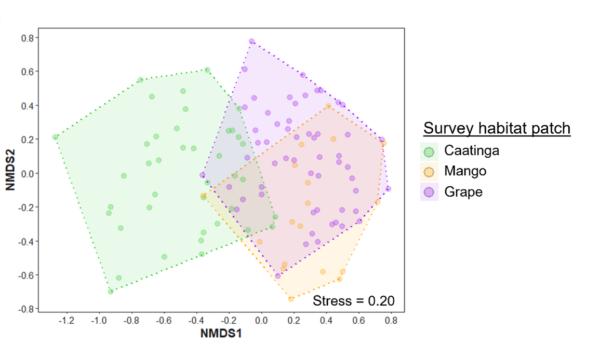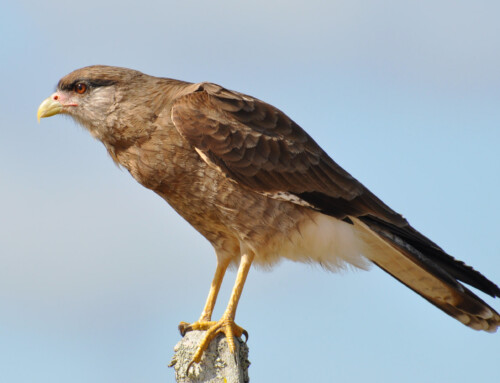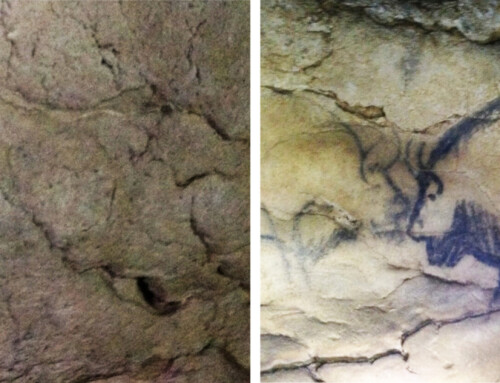LINKED PAPER
Distinct bird communities in forests and fruit farms of Caatinga landscapes. Zielonka, N.B., Arellano, E., Crowther, L.P., Ferreira, V., Muñoz-Sáez, A., Oliveira-Rebouças, P., da Silva, F.O., Butler, S.J., Dicks, L.V.. 2024. IBIS. DOI:10.1111/ibi.13311 VIEW
Grapes and mangoes may be a common sight in your fruit bowl, but have you ever wondered where the fruits come from? Well, let me take you on a journey to the ‘white forests’ of the Brazilian Caatinga – a diverse tropical dryland of thorny and semi-arid vegetation that appears dormant and white for most of the year, and bursts into life and greenery over the short rainy season. Despite the challenging conditions, over 2,000 species of plants and animals have made Caatinga their home, including dozens of endemic species not found anywhere else (da Silva et al. 2017). Over the past three decades, the region has also become home to irrigated fruit farms, which are always green, linear and heavily managed – a stark contrast to the forests of Caatinga (Figure 1). This rise in fruiticulture has been fuelled by the increasing demands for fruit exports to the Global North, and this has hugely benefitted regional development and poverty reduction. But how have the local bird communities responded to these habitat changes – are there winners or losers?

Figure 1. Example of a grape farm and the surrounding Caatinga forest in north-eastern Brazil during the wet season © Natalia Zielonka.
Agricultural expansion that leads to the loss of native habitats, and agricultural intensification which is associated with agrochemical use and habitat homogenisation, are key biodiversity threats and lead to losses in species richness and abundance (Newbold et al. 2016, Jaureguiberry et al. 2022). Beyond the direct losses, agricultural habitats can be characterised by altered communities, as some species are able to persist, or even benefit from the changes, whilst others decline in numbers and can ultimately disappear. Species’ responses are often explained by their ability to adapt to changes (such as habitat or food availability), and to deal with new or additional pressures (such as human disturbance), and so, broadly speaking, generalist species that thrive under a wider range of conditions persist at the expense of specialist species that require a more unique set of resources.
Loss of Birds
We surveyed birds across the agricultural landscapes of Caatinga to compare the communities in the fruit farms (table grape and mango) and forest patches. In short, bird abundance and diversity were significantly lower in the fruit farms compared to the forest patches: for every individual and species recorded within the fruit farms, there were 1.6 within the remnant Caatinga forest patches. Altogether, we recorded 78 different bird species across the landscapes, of which, 66 species (85%) used the forest patches, 48 (62%) used the grape farm and 28 (36%) used the mango farms.
Distinct Bird Communities
What is most interesting are the changes in the bird communities as we found fruit farms and Caatinga forest patches to be characterised by near-distinct assemblages, which were composed of different species (Figure 2). Some of these differences were expected – species with specialist diets were significantly less abundant in the fruit farms than in the Caatinga forests patches that they are adapted to. This included species that feed on insects (insectivorous species), which may struggle to find sufficient food within the fruit farms that heavily rely on agrochemicals and lack refugia for prey. Such species are also frequently more sensitive to human disturbance and more likely to avoid crossing into the farms, even if they exist in the nearby forest patches. This is most concerning in the case of endemic species, such as the Caatinga Cacholote Pseudoseisura cristata and Campo Troupial Icterus jamacaii (Figure 3), which almost completely avoided the fruit farms in our study landscapes, and so, their persistence in the region may be threatened by continual agricultural growth

Figure 2. Non-metric multidimensional (NMDS) scaling of the abundance and composition of bird communities considering individual species across fruit farm and remnant Caatinga forest patches. Coloured points represent survey sites (n = 114) in each habitat patch, and the minimum convex polygons group these according to the survey habitat patch.
The winners across the fruit farm landscapes were species that can make use of a wide range of conditions and resources, such as omnivorous species (feed on a variety of foods), which made up 61% of all observed individuals. Unsurprisingly, 75% of the bird species we recorded are known to be able to adapt and thrive in human modified environments. The farm communities were dominated by a handful of species characterised by these traits, such as Picui Ground Dove Columbina picui, White-throated Seedeater Sporophila albogularis (endemic), Red-cowled Cardinal Paroaria dominicana (endemic), Common Waxbill Estrilda astrild (non-native) and House Sparrow Passer domesticus (non-native; Figure 3). Whilst this shows us that some endemic species are likely to persist, the list also includes two non-native species that were almost exclusively found within the farms, hinting at how continual expansion of fruit farms may change local bird assemblages.

Figure 3. Example bird species recorded across fruit farm and forest patches in the Caatinga, north-eastern Brazil © authors credited within the panel CC BY Wikimedia Commons.
Future Conservation
As far as fruit farm expansion across the Caatinga goes, our results suggest that its continuation may lead to the homogenisation of local bird communities. To help counteract this, retaining patches of the Caatinga forest and increasing habitat heterogeneity may help to support a higher number of bird (and non-bird) species and maintain regional connectivity (Salazar et al. 2021). More widely however, we argue that expanding the proportion of land under strict, legal protection away from agricultural areas may be key to the conservation of the highly biodiverse Caatinga biome. And finally, as consumers, we can become more mindful when reaching for tropical fruits and do our bit by supporting more sustainably produced food and avoiding waste.
References
Jaureguiberry, P., Titeux, N., Wiemers, M., Bowler, D.E., Coscieme, L., Golden, A.S., Guerra, C.A., Jacob, U., Takahashi, Y., Settele, J., Díaz, S., Molnár, Z., Purvis, A. 2022. The direct drivers of recent global anthropogenic biodiversity loss. Science Advances 8:45. VIEW
Newbold, T., Hudson, L.N., Arnell, A.P., Contu, S., de Palma, A., Ferrier, S., Hill, S.L.L., Hoskins, A.J., Lysenko, I., Phillips, H.R.P., Burton, V.J., Chng, C.W.T., Emerson, S., Gao, D., Pask-Hale, G., Hutton, J., Jung, M., Sanchez-Ortiz, K., Simmons, B.I., Whitmee, S., Zhang, H., Scharlemann, J.P.W., Purvis, A. 2016. Has land use pushed terrestrial biodiversity beyond the planetary boundary? A global assessment. Science 353:6296. VIEW
da Silva, J.M., Leal, I., Tabarelli, M. (eds). 2017. Caatinga: The Largest Tropical Dry Forest Region in South America. Springer International Publishing. VIEW
Salazar, A.A., Arellano, E.C., Muñoz-Sáez, A., Miranda, M.D., Oliveira da Silva, F., Zielonka, N.B., Crowther, L.P., Silva-Ferreira, V., Oliveira-Reboucas, P., Dicks, L.V. 2021. Restoration and conservation of priority areas of Caatinga’s semi-arid Forest remnants can support connectivity within an agricultural landscape. Land 10:550. VIEW
Blog posts express the views of the individual author(s) and not those of the BOU.
If you want to write about your research in #theBOUblog, then please see here.




